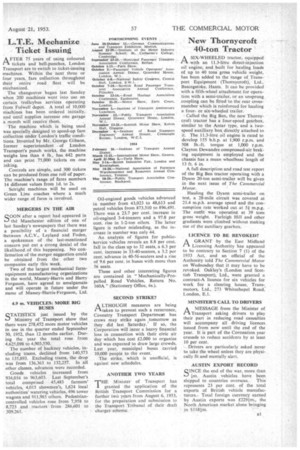L.T.E. Mechanize • Ticket Issuing
Page 35

If you've noticed an error in this article please click here to report it so we can fix it.
AFIER 75 years of using coloured tickets and bell-punches, London Transport are to switch to ticket-issuing
machines. Within the next three or four years, fare collection throughout their entire road fleet will be mechanized.
The changeover began last Sunday when 200 machines went into use on certain trolleybus services operating from Fulwell depot. A total of 10,000 machines has been ordered initially, and until supplies increase one garage a month will receive them.
The machine which is being used was specially designed to speed-up fare collection under London's traffic condi tions. Invented by Mr. George Gibson, former superintendent of London Transport's punch works, the machine weighs less than 4 lb., has 642 parts and can print 75,000 tickets on one inking.
Controls are simple, and 300 tickets can be produced from one roll of paper. The machine's range of fares numbers 14 different values from Id. to 2s.
Setright machines will be used on Green Line coaches where a much wider range of fares is involved.
MERGERS IN THE AIR
SOON after a report had appeared in the Manchester edition of one of last Sunday's newspapers that there was a possibility of a financial merger ‘between A.C.V„ Leyland and Foden, a spokesman of the last-mentioned concern put out a strong denial of the likelihood of this happening. No confirmation of the merger suggestion could be obtained from the other two companies early this week.
Two of the largest mechanical farmequipment manufacturing organizations in the world, Massey-Harris and Harry Ferguson, have agreed to amalgamate and will operate in future under the name of Massey-Harris-Ferguson, Ltd.
4.9 m. VEHICLES: MORE BIG BUSES
STATISTICS just issued by the Ministry of Transport show that there were 278,452 more motor vehicles in use in the quarter ended September 30, 1952, than 12 months earlier. During the year the total rose from 4,625,098 to 4,903,550.
The number of hackney vehicles, including trams, declined from 140,573 to 135,893. Excluding trams, the drop was from 136,363 to 132,257. In all other classes, advances were recorded.
Goods vehicles increased from 934,016 to 963,603. Last September's total comprised 45,483 farmers' vehicles, 4,015 showmen's, 1,624 local authorities' watering vehicles, 496 tower wagons and 911,985 others. Pedestriancontrolled vehicles rose from 7,958 to 8,723 and tractors from 286,601 to 309,261. Oil-engined goods vehicles advanced in number from 43,023 to 48,613 and petrol vehicles from 873,310 to 896,491. There was a 23.7 per cent. increase in oil-engined 3-4-tonners and a 97.8 per cent. rise in 1-2-ton oilers. The latter figure is rather misleading, as the increase in number was only 44.
An analysis of figures for publicservice vehicles reveals an 8.8 per cent. fall in the class up to 32 seats, a 6.3 per cent. increase in 33-40-seaters, a 3.2 per cent, advance in 40-56-seaters and a rise of 9.6 per cent. in buses with more than 56 seats.
These and other interesting figures are contained in "Mechanically-Propelled Road Vehicles, Return No. 160A" (Stationery Office, 6s.).
SECOND STRIKE?
LTHOUGH measures are being r*Itaken to prevent such a recurrence, Coventry Transport Department bus crews may strike again Jomorrow as they did last Saturday. If so, the Corporation will incur a heavy financial loss in connection with their civic air day which has cost £2,000 to organize and was expected to draw large crowds. Last year, municipal buses carried 10,000 people to the event.
The strike, which is unofficial, is against new schedules.
ANOTHER TWO YEARS
THE Minister of Transport has granted the application of the British Transport Commission for a further two years from August 6, 1953, for the preparation and submission to the Transport Tribunal of their draft charges scheme.




























































































